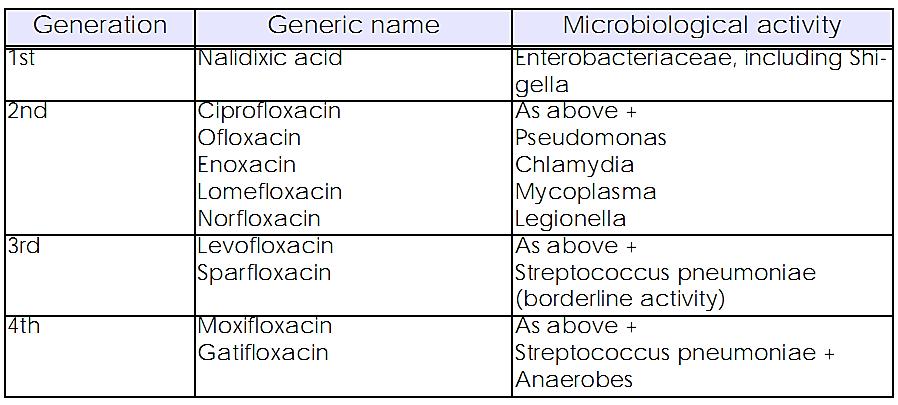


 النبات
النبات
 الحيوان
الحيوان
 الأحياء المجهرية
الأحياء المجهرية
 علم الأمراض
علم الأمراض
 التقانة الإحيائية
التقانة الإحيائية
 التقنية الحيوية المكروبية
التقنية الحيوية المكروبية
 التقنية الحياتية النانوية
التقنية الحياتية النانوية
 علم الأجنة
علم الأجنة
 الأحياء الجزيئي
الأحياء الجزيئي
 علم وظائف الأعضاء
علم وظائف الأعضاء
 الغدد
الغدد
 المضادات الحيوية
المضادات الحيوية|
Read More
Date: 23-3-2016
Date: 23-3-2016
Date: 24-3-2016
|
Quinolones
The classification of the quinolones into "generations" on the basis of microbiological activity is controversial, but is useful for practicing clinicians.
According to this classification, nalidixic acid is o first-generation quinolone. Because of its reliable activity against most Enterobactericeae, it became o popular choice for the treatment of uncomplicated urinary tract infections. Nalidixic acid is also used to treat shigellosis in children. lt requires dosing four times a day and is available only as an oral agent and does not achieve significant tissue levels. it hos no activity against Pseudomonas aeruginosa, anaerobes, chlamydia, mycoplasmas or Gram-positive bacteria.
The second-generation quinolones expanded the bacterial coverage to include Pseudomonas aeruginosa and staphylococci. These quinolones have modest-to-poor activity against streptococci (notably Streptococcus pneumoniae and enterococci) and anaerobes. They exhibit high intracellular penetration, allowing for therapy against intracellular organisms like chlamydia, mycoplasmas and legionellae.
A significant problem has been the emergence of resistance during therapy for infections caused by Staphylococcus aureus and Streptococcus viridans. The second-generation quinolones can be divided into two subgroups. One group contains ciprofloxacin and ofloxacin, which are available in both oral and parenteral formulation. and can be used to treat minor and severe infections such as urinary tract infections. severe enteric infections caused by salmonellae or Shigella, gonorrhoeae and typhoid fever. The other group contains agents available only as oral formulations (e.g. enoxacin, lomefloxacin, norfloxacin), which are used primarily for urinary tract infections. ln general, these agents should be reserved for treatment of significant infections caused by Pseudomonas aeruginosa or other Gram-negative bacteria which are resistant to conventional antibiotics.

The third-generation quinolones have similar activity to the second-generation quinolones. plus increased activity against Streptococcus pneumoniae. However, they are less active than the second-generation quinolones against Gram-negative bacteria. Activity against anaerobes is modest-to-poor. Levofloxacin and sparfloxacin belong to this group of quinolones. These quinolones should ideally be reserved for use as alternatives to other agents for acute exacerbations of chronic bronchitis and bacterial pneumonia in elderly patients.
Moxifloxacin and gatifloxacin can be considered fourth-generation quinolones owing to their activity against anaerobes, and significantly increased activity against Streptococcus pneumoniae. Hence, these might be considered for the treatment of intraabdominal infections (of intestinal or pelvic origin) in addition to respiratory tract infections (as for the third generation quinolones).



|
|
|
|
علامات بسيطة في جسدك قد تنذر بمرض "قاتل"
|
|
|
|
|
|
|
أول صور ثلاثية الأبعاد للغدة الزعترية البشرية
|
|
|
|
|
|
|
مكتبة أمّ البنين النسويّة تصدر العدد 212 من مجلّة رياض الزهراء (عليها السلام)
|
|
|